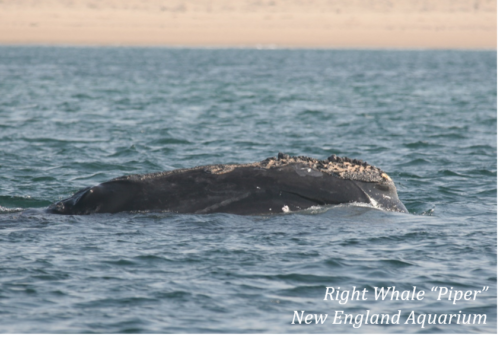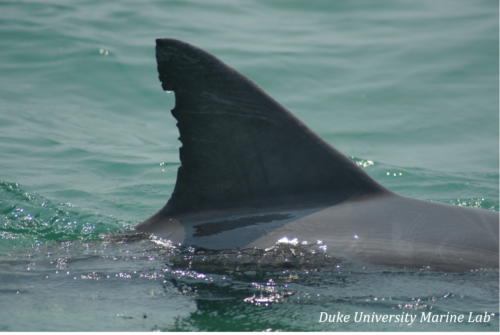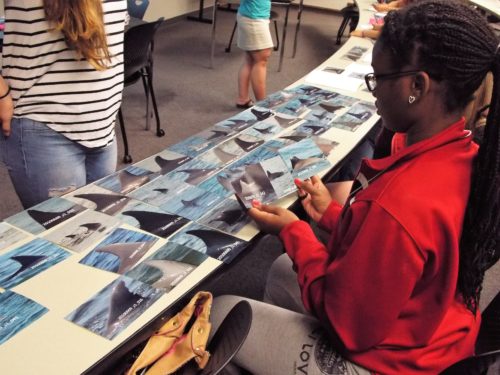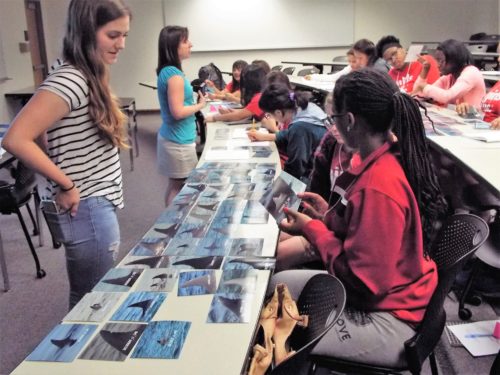 Azura recently volunteered for the Girls Inc. Eureka! Program at the University of Texas at Dallas during June. Eureka! is designed to engage girls ages 12 to 18 in exploring STEM (science, technology, engineering and mathematics) to motivate girls to pursue post-secondary education and careers in STEM fields. This year, we introduced the girls to a technique that marine mammal scientists use to study the distribution, movement patterns, abundance, and social interactions of whales and dolphins.
Azura recently volunteered for the Girls Inc. Eureka! Program at the University of Texas at Dallas during June. Eureka! is designed to engage girls ages 12 to 18 in exploring STEM (science, technology, engineering and mathematics) to motivate girls to pursue post-secondary education and careers in STEM fields. This year, we introduced the girls to a technique that marine mammal scientists use to study the distribution, movement patterns, abundance, and social interactions of whales and dolphins.
Photo-identification is the process of using photographs of natural markings to distinguish one individual animal from another. Just like we have different hair styles, skin tones, freckle patterns, and other physical features that distinguish us from one another, many species of whales and dolphins have physical characteristics that are unique to individuals. For example, individual humpback whales have different patterns of black and white coloration on the undersides of their tail fins (flukes), and bottlenose dolphins have different nick and notch patterns along the trailing edges of their dorsal fins.
During our photo-identification activities, the girls got to act like real marine scientists and analyze actual photographic data of North Atlantic right whales and bottlenose dolphins.
North Atlantic Right Whales
The girls analyzed images of mostly the faces (or heads) of some North Atlantic right whales since their most distinguishing characteristic is the pattern of callosities on the top of their heads. These patches of raised tissue are dark but are covered with light-colored cyamids called “whale lice” which make the callosities easy to see even from a distance. The placement and pattern of the callosities are unique to each individual right whale.
The identification of individual right whales is very important research since this species is critically endangered. Less than 500 right whales live along the eastern coast of the U.S. and Canada. The New England Aquarium keeps a catalog of all of the right whale identification photos for this population.
Each girl received a photo of her own right whale and compared the unique callosity patterns of her whale to the whales in a mini version of the Aquarium’s catalog. Once she identified which whale in the catalog was hers, she got to read about the history of her whale and see a map of some of the locations where her whale has been sighted along the eastern coast of the U.S.
 The girls all had a variety of female and male right whales of all ages. For example, the female right whale “Piper” was first sighted in 1993 and had her first calf in 2006. She was often sighted up and down the eastern coast between the feeding grounds off New England and the calving grounds off Florida and Georgia until she passed away in 2015.
The girls all had a variety of female and male right whales of all ages. For example, the female right whale “Piper” was first sighted in 1993 and had her first calf in 2006. She was often sighted up and down the eastern coast between the feeding grounds off New England and the calving grounds off Florida and Georgia until she passed away in 2015.
Bottlenose Dolphins
 Marine mammal scientists have been using photo-identification techniques to study bottlenose dolphins for many decades. After the girls became pros at right whale identification, they got to spend some time learning how to identify bottlenose dolphins using the nicks, notches, scars, and other unique patterns evident on their dorsal fins.
Marine mammal scientists have been using photo-identification techniques to study bottlenose dolphins for many decades. After the girls became pros at right whale identification, they got to spend some time learning how to identify bottlenose dolphins using the nicks, notches, scars, and other unique patterns evident on their dorsal fins.
Using real photographic data collected from two surveys on bottlenose dolphins off the coast of North Carolina, the girls sorted and matched images of dorsal fins from each survey and then looked for matches across the two surveys.
 They first weeded out the “clean” fins that did not have distinguishing marks and then looked for nicks, notches, and tears but not scrapes or scratches which can heal over time.
They first weeded out the “clean” fins that did not have distinguishing marks and then looked for nicks, notches, and tears but not scrapes or scratches which can heal over time.
Since researchers often assign a name along with a number to each identifiable dolphin, the girls had a great time naming their unique dolphins. Their imaginations and creativity ran wild as they named the dolphins based on their nick/notch patterns!

After making their matches within and across the surveys, the girls got to use a bit of math to calculate the size of their population of North Carolina dolphins. This mark-recapture method uses the number of identified (marked) dolphins during the 1st survey, the number of dolphins identified during the 2nd (recapture) survey, and the number of dolphins matched between the two surveys. By using this mark-recapture method, researchers can assess the abundance of a population over a period of time to see if the population is decreasing or increasing.
Special thanks to Kim Urian (Duke University Marine Lab) and Heather Pettis (New England Aquarium) for providing the images, data, and information for these activities. Azura and the Girls Inc. girls greatly appreciate your contributions which made these activities possible.

